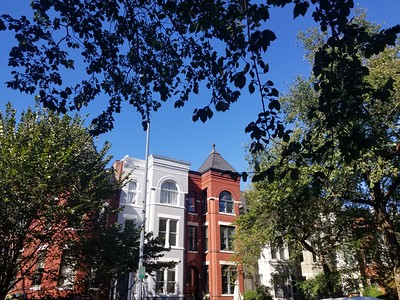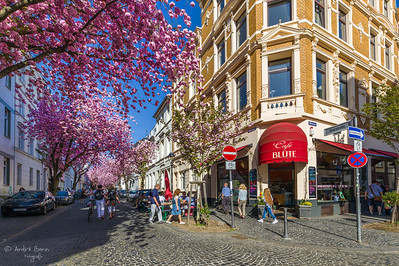Arbor Day: Friday April 24th, 2020
Past entries include:
-- 2019
-- 2018
-- 2016
DC has the Casey Trees organization, which was funded by a philanthropist to focus on improving the tree environment across the city, not just where the street meets the sidewalk.
Some programs I've come across recently include:
A multifaceted sustainability nonprofit group in the Kansas City area called Bridging The Gap. One of their initiatives is the Heartland Tree Alliance, which promotes tree care and plantings.
The City of Albuquerque has a small sales tax with a fraction dedicated to street improvements, particularly median plantings. It has softened the character of many otherwise wide streets across the city. But it isn't focused on "re-treeing" commercial districts or neighorhoods, although there is a separate Albuquerque NeighborWoods program for neighborhoods.
Trees Atlanta -- similar to Casey Trees.
On the pro-urb list, architect, designer and author Steve Mouzon wrote a great piece about the value of street trees. This is the first part of what he wrote.
Direct Effects of Street Trees
1. Properly placed street trees shade the sidewalk. This can result in a reduction of 20° - 45° in sidewalk temperature, according to Lance Hosey. Sidewalks store a lot of heat due to their mass and then radiate that heat to everything around them, especially including the people walking on them.

2. Street trees also shade the people walking on the sidewalk. Walking in the shade versus walking in the sun can easily make a perceived difference of 20° due to solar radiation on your skin.
3. Street trees transpire, meaning that they give off water vapor through evaporation of moisture from their leaves. The misting fans found often in warm climates like South Beach where we lived for 16 years cool people sitting at sidewalk cafes have a similar and more visible effect because you can see the mist whereas you can’t see the water vapor from the trees, even though it cools you almost as well. Evapotranspiration from trees can reduce temperatures around the trees by 2° - 9°, again according to Hosey. This compounds the cooling effect of shading.
4. Street trees are usually considered beautiful by most people in town. And street trees are the only things we install on a streetscape that get bigger and more beautiful over time all on their own. But beauty isn’t the only way they appeal to our senses. “Street trees help you know when you are because of how they behave across the seasons.” ~ Victor Dover
5. Properly placed street trees (between sidewalk & travel lanes) physically protects people walking on the sidewalk because a car is likely to strike a tree before getting to someone walking. Trees near the street also encourage drivers to slow down because no sane driver wants to wrap their car around a tree, as the tree almost always wins. Street trees have been shown to be as effective against speeding as speed cameras, according to The Telegraph.
Baltimore's real estate pricing lags housing value. But housing prices in areas with parks, squares, and street trees do better. This house is in the Union Square area.
6. Because street trees are beautiful, they raise the value of the real estate around them if properly selected. On mostly residential streets, their lowest limbs should be above head height; on mostly commercial streets, their lowest limbs should be above the sign band of the adjacent businesses.
As to the value, one street tree on a block raises the value of every house on the block by $2,000 except the house where the street tree is located, the value of which is raised $7,000. If the street is lined with trees, the value of every house is raised by $22,000. This data is from Doug Kelbaugh.
Dan Burden says that while the planting & 3-year maintenance cost of a relatively large-caliper street tree is probably $250 - $600, the lifetime benefits of that tree will be around $90,000. This means that street tree programs can be largely self-financing in all except poor neighborhoods because once people understand this, many will plant their own street trees to jump-start their home appreciation. Beyond the street, studies show home buyers & real estate agents assign 10%-23% of lot value to trees on the lot, according to Kaid Benfield.

7. Because street trees are beautiful, they are good indicators of the most-loved parts of town, increasing not only the real estate value, but also the stature of the neighborhood. Recovery of a seriously disinvested place should begin early on with a street tree program because street trees change the perception of the place from a place where nothing is possible to a place where “you never know what good might happen there.”

When I’m scouting a town I don’t know for possibly shooting a volume for the Catalog of the Most-Loved Places I drive a major street and look down the side streets looking for street trees. Almost without exception, places with lots of street trees are the most-loved neighborhoods in town. No sign of a vibrant, lovable place can be seen from further down the street than a line of street trees. Test this all yourself.
8. Street trees reduce crime. A recent Baltimore study showed that 10% more street trees = 12% less crime. Why this is so is no mystery. More street trees = stronger Walk Appeal = more people walking = more eyes on the street = less crime, as Jane Jacobs said 60 years ago.

9. Street trees are good for business. Lining streets with street trees leading to a neighborhood center draws customers in to neighborhood businesses from surrounding neighborhoods by elevating Walk Appeal. Jeff Tumlin says that street trees are a critical economic development and sustainability investment. And they’re good for the economy of a neighborhood in general. According to Patrick Kennedy, Every street tree absorbs the first inch of stormwater. They can save billions in stormwater infrastructure across the city.
10. Trees are carbon champions. They continually inhale carbon dioxide and exhale oxygen, while humans and other animals do the opposite. They also sequester carbon within the tree as the tree grows. Plant enough trees, and they will actually absorb all carbon emitted by humans today. That number is currently 1.2 trillion trees.
Unfortunately, humans are going the wrong direction by burning the Amazon and deforesting all over for more cattle farming. But planting street trees would at least be a start in the right direction.
If there are 4 million miles of streets and roads in the US today and street trees were planted 25 feet on center on either side of all of them, that would total almost 1.7 billion trees. That’s a small fraction of 1.2 trillion, but definitely a step in the right direction. Just. Quit. Destroying. What’s. Already. Growing!
Labels: "streets as places", green-environment-urban, public realm framework, trees and urban forestry, urban design/placemaking



8 Comments:
1. This is an extremely heartening, well written article
2. I didn't know you lived in Miami for 16 yrs!
No, no, no. (My brother, yes, well South Florida.)
This was a reprint of an article by Steve Mouzon.
From the pro-urb list:
Grand Rapids Michigan has the non-profit Friends of Grand Rapids Parks. One of their programs is to increase urban tree canopy per the goals established by the city master plan and the downtown plan (GR Forward). They call it the urban forest project.
These trees are planted mostly in the public right-of-way of streets, but also in parks.
https://www.friendsofgrparks.org/urban-forest-project/
Friends has also begun an extensive inventory of all city trees, here https://pg-cloud.com/michigan/?org=Grand%20Rapids
In downtown, where there is a significant lack of street trees, we have teamed with this group to plant around 200 trees per year. We have also begun working with them to make sure that the trees are cared for properly, including proper trimming. Maintenance has been a long-standing issue with the city because of funding, staffing, and priority - so the non-profit is beginning to take it on.
Additionally, most new trees planted in the downtown streetspaces have below-grade soil connections with a floating slab (pinned from back of curb to the adjacent at-grade sidewalk) to give the tree root system connectivity to other trees and a much larger below ground habitat. In these cases, the above-ground tree wells are typically all connected underground on a single block. We also have begun experimenting with the tree cells that John spoke of, currently, we are using the GreenBlue soil cells.
And as a bonus, we just convinced the city to install 5 London Plane trees on a street project, in lieu of Callery Pears.
Mark Miller
Downtown Grand Rapids Inc
https://www.theguardian.com/environment/2020/may/16/how-urban-planners-preference-for-male-trees-has-made-your-hay-fever-worse
Friends of the Urban Forest, tree planting initiative in SF.
https://www.fuf.net/
From pro-urb, John Hooker writes:
studies by Eric Dumbaugh:
http://www.naturewithin.info/Roadside/TransSafety_JAPA.pdf
A PowerPoint by Eric:
http://www.isatexas.com/images/Conference/12/2012_Presentations/Street_Trees_and_Safety%20_Dumbaugh.pdf
https://www.facebook.com/street.trees
On the pro-urb list, Donald Shoup writes:
Most cities need safer sidewalks and more street trees, but many cities can’t or don’t want to pay for them.
One way to solve the finance problem is to require property owners to repair any broken sidewalk or plant any missing street tree in front of their property before they sell the property. This pay-on-exit policy systematically improves all streetscapes in a surprisingly short time at no cost to taxpayers. Owners who sell their property and leave the neighborhood make all the public improvements
Here is the link to an op-ed about repairing sidewalks at the point of sale:
https://www.latimes.com/opinion/op-ed/la-oe-0819-shoup-los-angeles-sidewalks-20140819-story.html
Here is the link to an op-ed about planting street trees at the point of sale:
https://www.dropbox.com/s/6i2v55am9847y0u/Let%20a%20Tree%20Grow%20in%20L.A.pdf?dl=0
Here is the link to magazine article on the point-of-sale policy for neighborhood public investments:
http://www.accessmagazine.org/wp-content/uploads/sites/7/2016/01/access-36brokensidewalks.pdf
Here is the link to an academic article in the Journal of the American Planning Association that analyzes the point-of-sale policy for planting street trees:
http://shoup.bol.ucla.edu/RegulationAtSale.pdf
And, finally, here is the link to an academic article in the Journal of Planning and Development that analyzes the point-of-sale policy for repairing sidewalks:
http://shoup.bol.ucla.edu/PuttingCitiesBackOnTheirFeet.pdf
"Rooftop forests are the future"
Salt Lake Tribune, 10/5/2020
The relationship between tree canopy and crime rates across an urban-rural gradient in the greater Baltimore region
https://www.fs.usda.gov/treesearch/pubs/40701
Post a Comment
<< Home